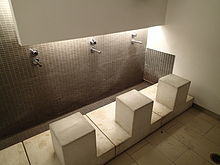Ritual purification
Ritual purification is the ritual prescribed by a religion by which a person is considered to be free of uncleanliness. Many religions require that those worshipping should be in this state. Ritual purity is a state of ritual cleanliness. Ritual purification may also apply to objects and places. Ritual uncleanliness is not identical with ordinary physical impurity, such as dirt stains; nevertheless, body fluids are generally considered ritually unclean.


Most of these rituals existed long before the germ theory of disease, and figure prominently from the earliest known religious systems of the Ancient Near East. Some writers connect the rituals to taboos.
Some have seen benefits of these practices for health and preventing infections especially in areas where humans come in close contact with each other. While these practices came before the idea of the germ theory was public in areas that use daily cleaning, the destruction of infectious agents seems to be dramatic.[1] Others have described a 'dimension of purity' that is universal in religions that seeks to move us away from disgust, (at one extreme) and to uplift us towards purity and divinity (at the other extreme). Away from uncleanliness to purity, and away from deviant to moral behavior, (within one's cultural context).[2]
References
change- ↑ "Nitten Soji and the prevention of infections" Classical fighting arts vol 2 #18
- ↑ Haidt, Johnathan. The Happiness Hypothesis. Basic Books.